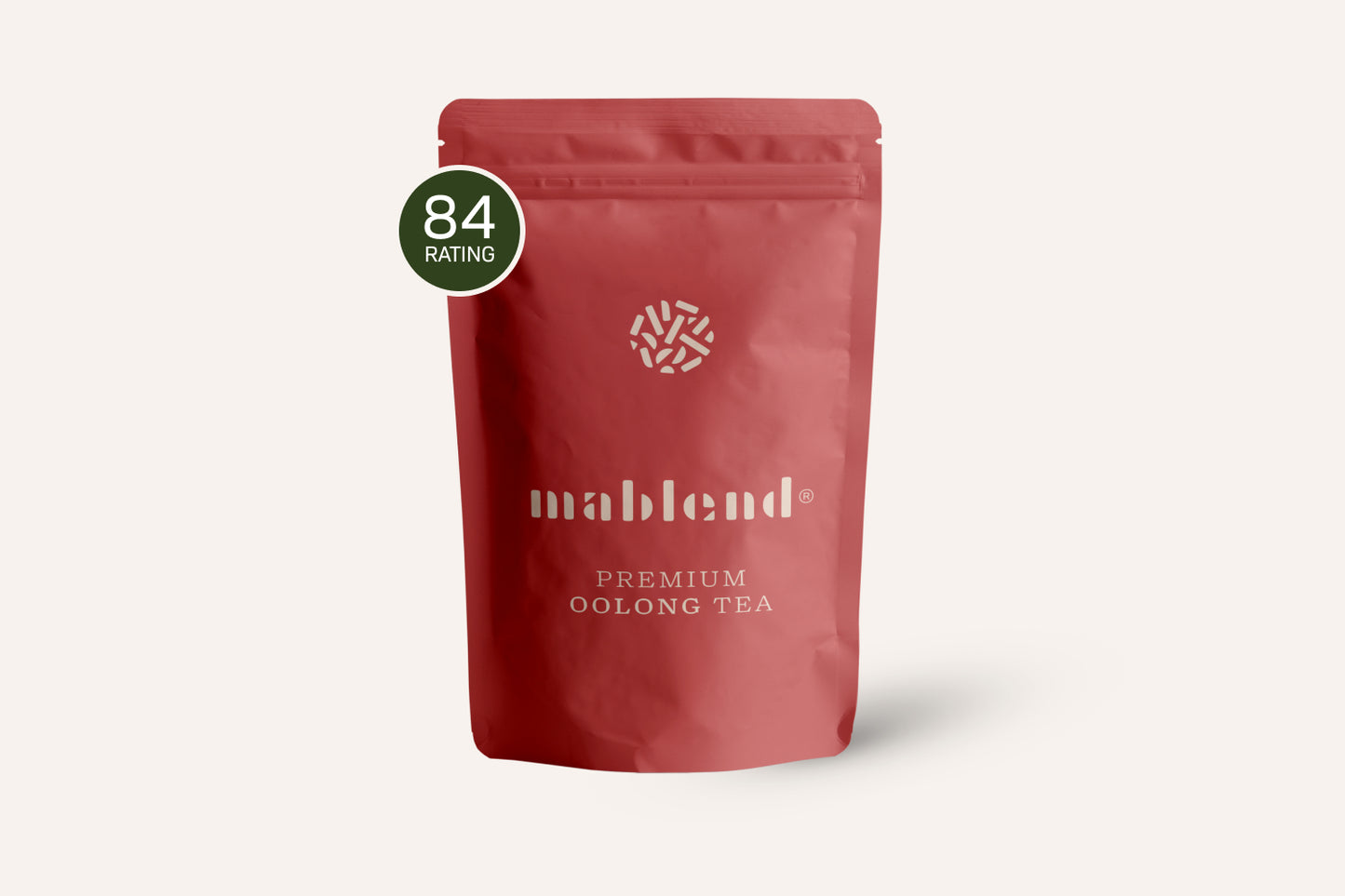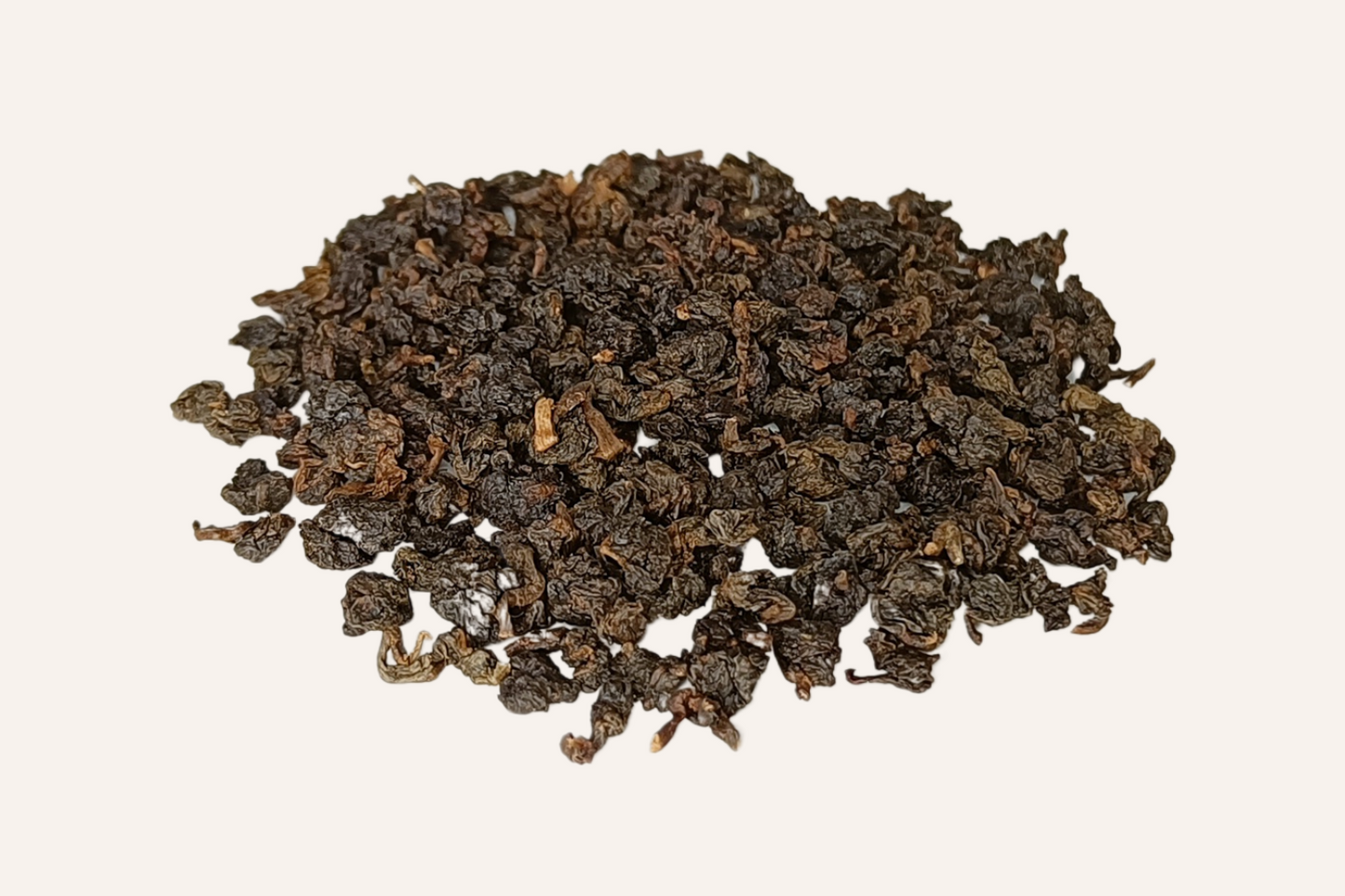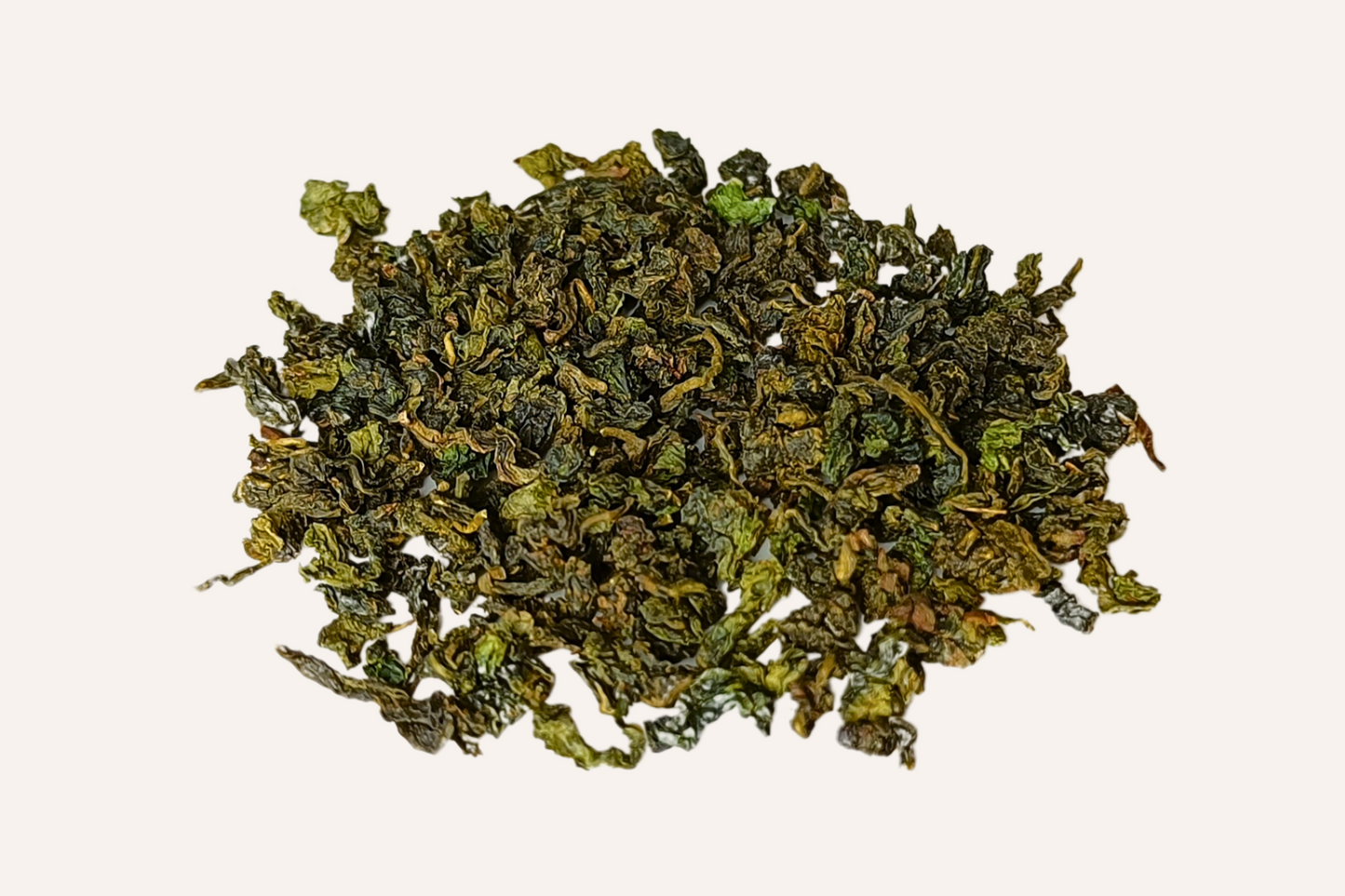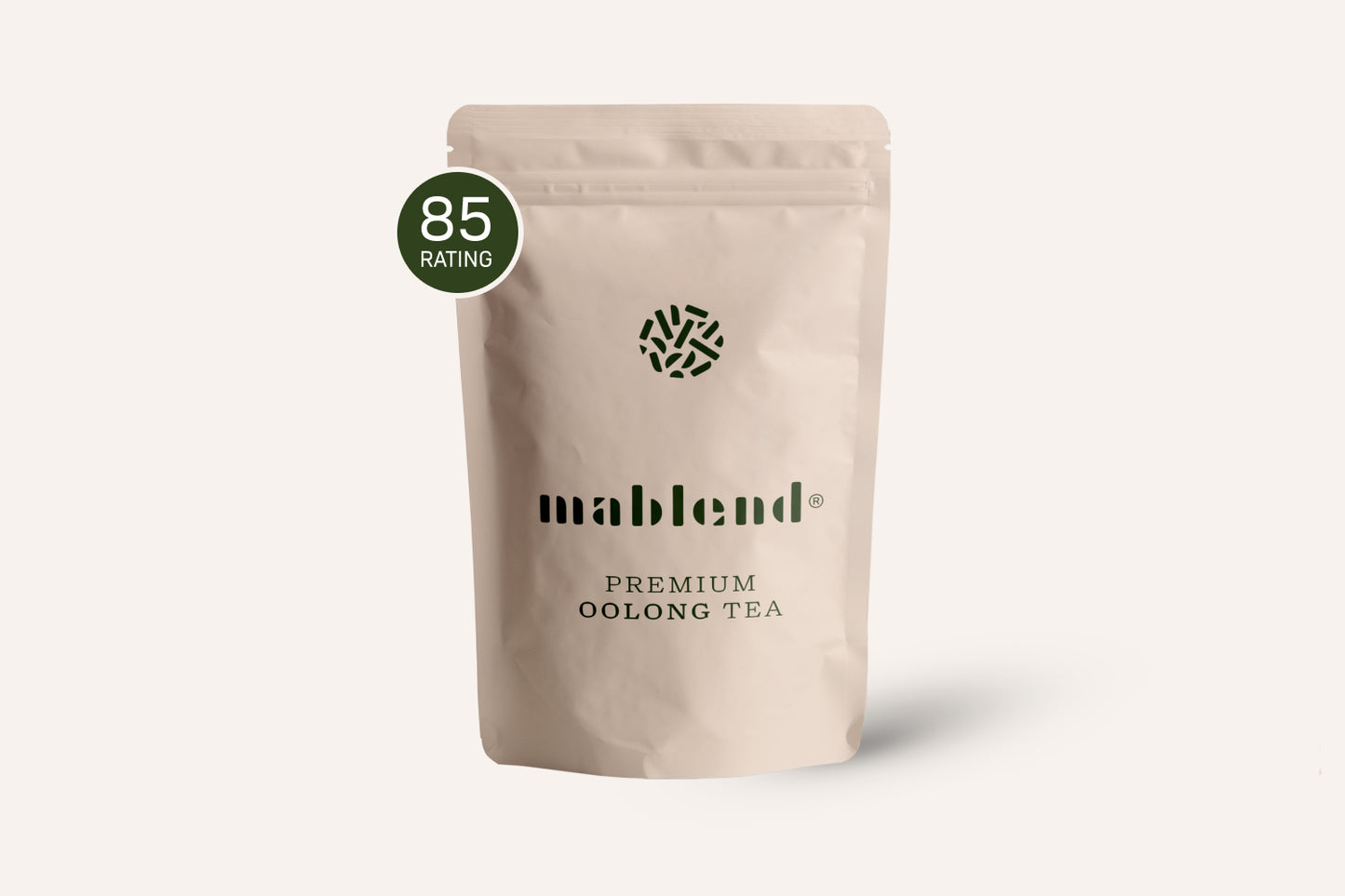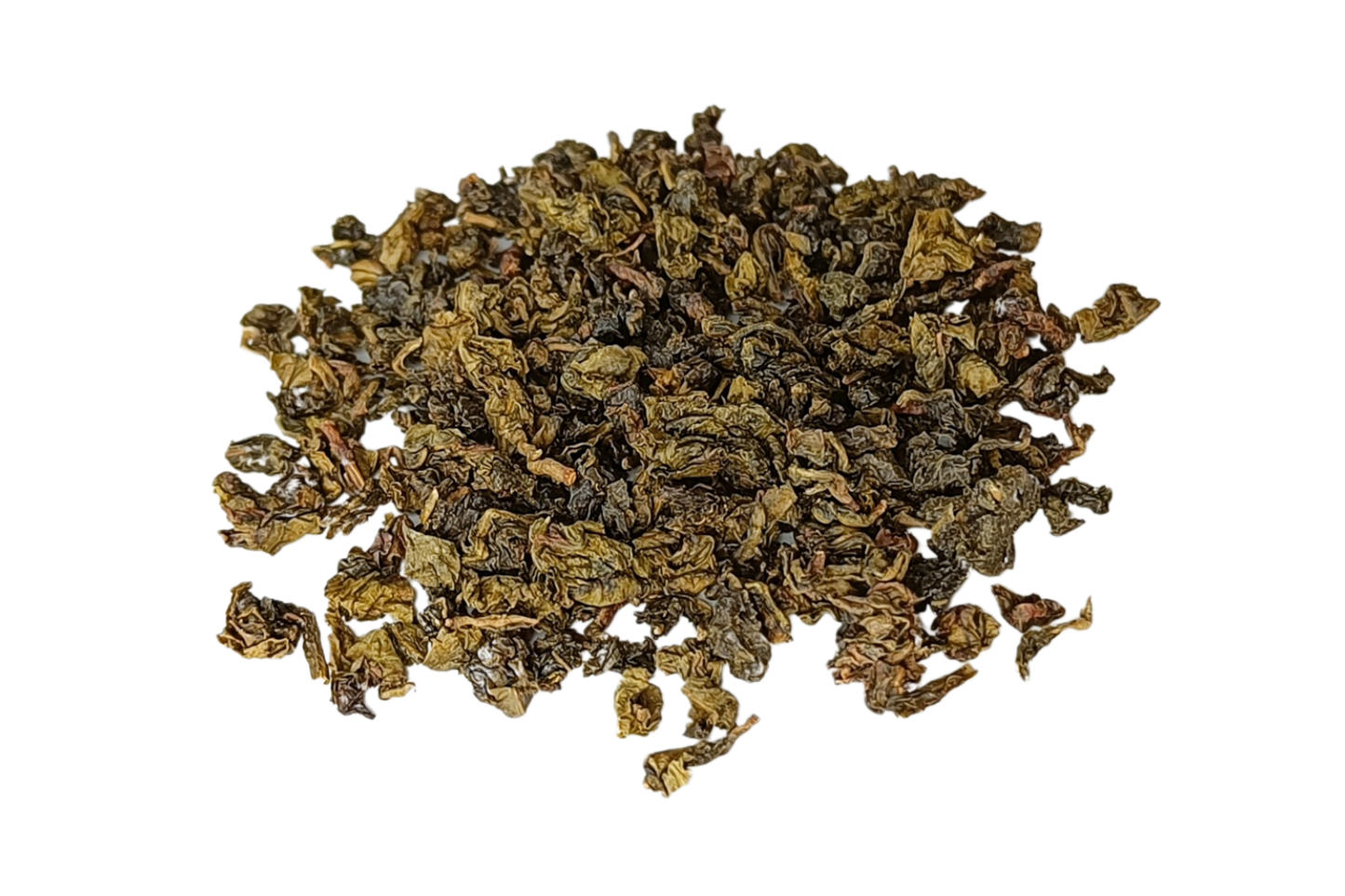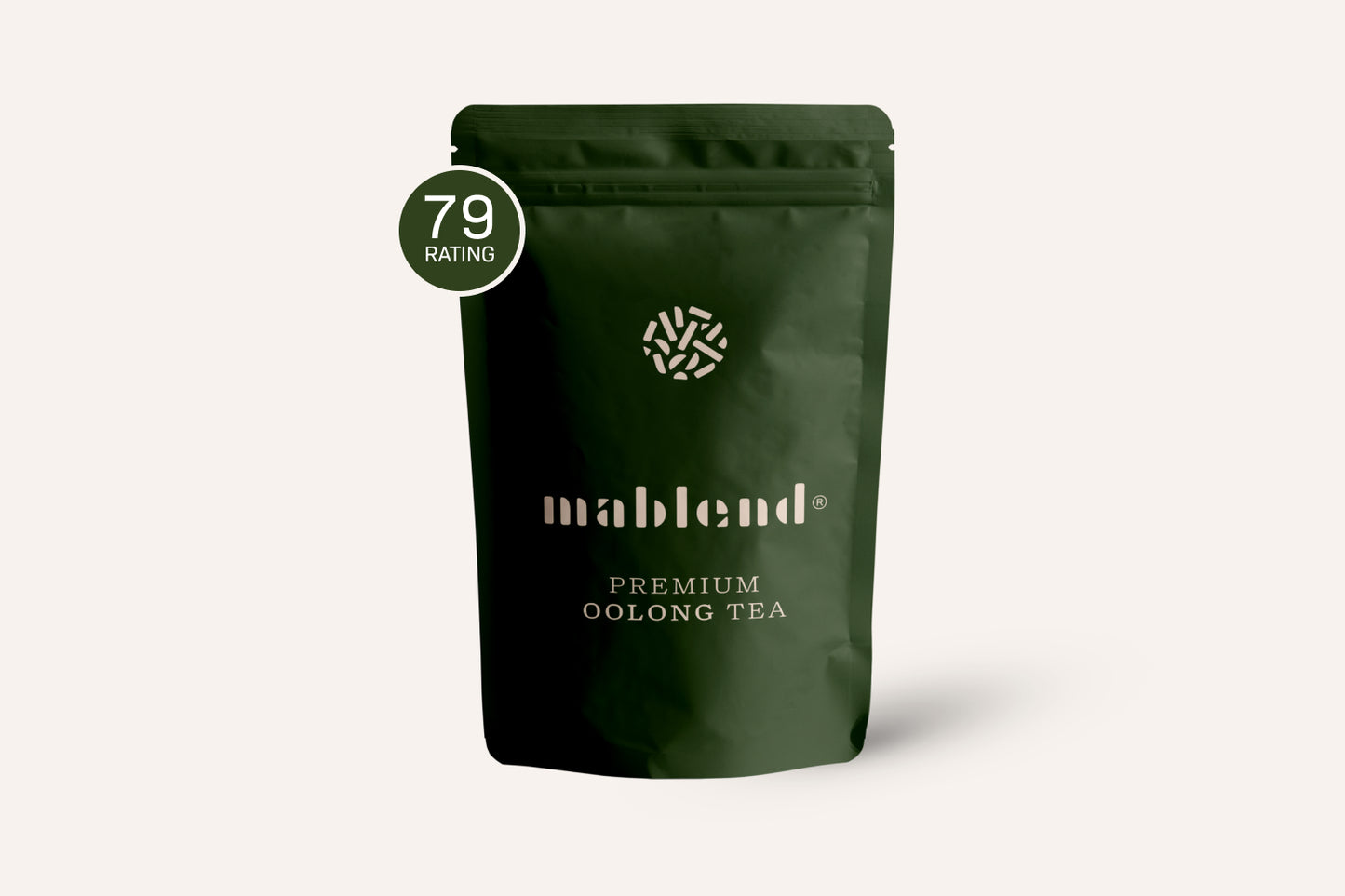Oolong tea, also known as 'wu long' or 'black dragon' tea, is a traditional Chinese tea that is intermediate between green tea and black tea in terms of oxidation.
Oolong tea is mainly produced in the Fujian and Guangdong provinces of China and in Taiwan. Oolong tea is known for its rich flavor and aroma, which can range from light and floral to dark and roasted , depending on the degree of oxidation and the production process.
The production process of oolong tea
The taste and aroma of oolong tea are affected by the oxidation process, which ranges from 8% to 85%.
The tea leaves are slightly wilted after picking, after which they are shaken to break the edges and promote oxidation.
The leaves are then roasted to stop oxidation and develop their distinctive flavor and aroma.
This roasting can range from light to heavy, resulting in a wide range of flavor profiles.
Oolong tea cultivars and areas
Each region has its own unique soil, climate and growing methods that contribute to the diversity of oolong tea. In China, oolong teas are usually made from the Camellia sinensis var. sinensis, while in Taiwan the Camellia sinensis var. formosa is used.
The cultivars can vary in leaf size, shape and color, resulting in different flavor profiles.
Is Oolong Tea Healthy?
Antihypertensive properties
Research has shown that drinking oolong tea regularly can help lower blood pressure.
The presence of antioxidants, such as catechins and flavonoids, in oolong tea helps relax blood vessels and improve blood flow.
As a result, oolong tea can help reduce the risk of high blood pressure and related health problems such as heart attacks and strokes.

Cholesterol and oolong tea
Oolong tea may also have a beneficial effect on cholesterol levels.
The antioxidants in oolong tea help lower LDL cholesterol (the "bad" cholesterol) and increase HDL cholesterol (the "good" cholesterol).
Due to this change in cholesterol levels, oolong tea can contribute to better heart health and reduce the risk of cardiovascular disease.
Immune system support
Oolong tea contains antioxidants such as catechins and flavonoids, which can strengthen the immune system.
These antioxidants help protect the body against free radicals and oxidative stress, which can lead to cell damage and a weakened immune system.
Drinking oolong tea regularly can make the body more resistant to infections and diseases. In addition, oolong tea also contains trace elements such as manganese, magnesium and selenium, which play an important role in supporting a healthy immune system.
Helps relieve stomach complaints
Oolong tea is known for its beneficial effects on digestion. The polyphenols and tannins in oolong tea help reduce inflammation in the gastrointestinal tract and support healthy digestion.
Drinking oolong tea can help relieve stomach complaints such as bloating, heartburn and indigestion.
Supports healthy intestinal flora
The antioxidants and polyphenols in oolong tea can also contribute to healthy intestinal flora. They help stimulate the growth of beneficial bacteria in the intestines, which are essential for proper digestion and maintaining a healthy immune system.
A balanced intestinal flora is crucial for absorbing nutrients, breaking down food and preventing infections.
Oolong Tea and Cognitive Function
Oolong tea contains caffeine, a stimulant known for its positive effects on cognitive function. Caffeine helps increase alertness, improve concentration and reduce fatigue.
Although the caffeine content in oolong tea is lower than coffee, it can still provide a subtle energy boost without the side effects of excessive caffeine intake, such as nervousness and insomnia.
Stress reduction and relaxation

Oolong tea also contains L-theanine, an amino acid that helps promote relaxation and reduce stress.
L-theanine works with caffeine to create a calming effect on the mind, which can lead to improved mood and mental focus.
Drinking oolong tea regularly can contribute to better mental health and general well-being.
Protection against free radicals
The antioxidants in oolong tea, such as catechins, flavonoids and theaflavins, play a crucial role in protecting the body against free radicals.
Free radicals are unstable molecules that can cause cell damage and contribute to aging and diseases such as cancer, heart disease and neurodegenerative disorders.
By drinking oolong tea regularly, the antioxidants in the tea can help neutralize free radicals and reduce the damage they cause.
Prevention of cell damage
In addition to neutralizing free radicals, the antioxidants in oolong tea can also help prevent cell damage. They promote cell repair and regeneration and protect the body against inflammation and chronic diseases.
Consuming oolong tea as part of a healthy diet can contribute to better long-term health and reduce the risk of disease.
Combating skin aging
The antioxidants in oolong tea, such as catechins and flavonoids, help combat skin aging. They protect the skin from damage caused by free radicals and UV rays, which can lead to wrinkles, fine lines and other signs of aging.
Drinking oolong tea regularly can contribute to healthy, radiant skin and slow down the aging process.
Reduction of inflammation
Oolong tea has anti-inflammatory properties that can help reduce skin inflammation and redness.
The polyphenols in oolong tea soothe the skin and help treat skin conditions such as eczema, psoriasis and acne. Adding oolong tea to your daily routine can have a positive effect on your skin health.
Potential side effects
Although oolong tea is generally considered safe, there are some potential side effects and precautions to keep in mind.
The caffeine content in oolong tea may cause some people to experience insomnia, nervousness or an increased heart rate. It's important to monitor your caffeine intake and listen to your body.
People with sensitivity to caffeine, pregnant women, and those with certain medical conditions may need to limit or avoid their oolong tea intake. Always consult a doctor before starting a new diet or health routine.
Can you lose weight with Oolong Tea?
Antioxidants and their role in fat burning

Oolong tea is rich in antioxidants, including catechins, which play a crucial role in supporting weight loss.
Catechins help increase energy expenditure and fat burning, which can lead to a reduction in body fat.
Research ( source ) has shown that the combination of catechins and caffeine, both present in oolong tea, is effective in stimulating fat oxidation and increasing metabolism.
Oolong tea and metabolism: a dynamic duo
Another way oolong tea supports weight loss is by boosting metabolism.
Metabolism is the process by which your body burns calories to produce energy. A higher metabolism means your body burns more calories, even at rest.
Studies have shown that oolong tea can increase metabolism, resulting in greater calorie and fat burning.
This increased combustion is mainly due to the presence of caffeine and the aforementioned catechins in oolong tea.
Oolong tea and calorie burning: myth or reality?
While some people claim that drinking oolong tea alone is enough to achieve significant weight loss, it is important to understand that tea alone is not the only solution.
Oolong tea can help increase calorie burning and boost metabolism, but these effects are usually relatively small compared to the impact of a healthy diet and regular exercise.
Oolong tea is best used as a supplement to other weight loss strategies, rather than as a miracle cure.
The role of oolong tea in a balanced diet
Oolong tea can be a valuable addition to a balanced diet aimed at weight loss.
Drinking oolong tea can help keep you hydrated and can serve as a low-calorie alternative to sugary drinks like soda and fruit juices.
Additionally, drinking oolong tea before or during meals can help suppress your appetite and leave you feeling satisfied with smaller portions.
It is important to remember that oolong tea is not a replacement for a healthy diet, but rather a supplement that can support weight loss.
Reducing feelings of hunger

One of the ways oolong tea can support weight loss is by reducing feelings of hunger and suppressing appetite.
The caffeine in oolong tea is known for its appetite suppressant properties, making you less likely to overeat or consume unhealthy snacks.
In addition, oolong tea can also help stabilize blood sugar levels, which can help reduce feelings of hunger and prevent binge eating.
It is important to know that excessive caffeine consumption can have negative side effects, so it is recommended that you limit your intake of oolong tea and other caffeinated drinks to a safe level.
Oolong tea vs other teas for weight loss
Although oolong tea has weight loss benefits, there are other types of tea that can have similar effects.
For example, green tea is known for its high levels of antioxidants, especially EGCG , which can boost fat burning and metabolism.
Black tea also contains catechins and caffeine, but to a lesser extent than oolong and green tea. It is important to note that each type of tea offers unique benefits, and combining different teas can contribute to a more balanced and varied diet aimed at weight loss.
Making oolong tea
Brewing this delicious tea can be done in different ways, depending on your preference and available time. Two popular methods of making oolong tea are:- The Western method
- The Traditional Chinese Method , or "gongfu cha"
Both methods offer a different experience and bring out different aspects of the oolong tea.
The Western method is simple and accessible, making it an excellent choice for those just beginning to explore the world of oolong tea.
Using a teapot or an infuser, the tea is brewed with fewer tea leaves and longer steeping times. This method produces a delicious cup of oolong tea with minimal effort and is perfect for everyday use. View our range of teapots for loose tea .
The Western method can be used in the office or in a coworking setting .

The Chinese gongfu cha method is a more ceremonial and detailed approach to making oolong tea. This method uses a gaiwan or small Yixing teapot and emphasizes enjoying the aroma, taste and texture of the tea. With more tea leaves and shorter steeping times, the goal of the gongfu cha method is to explore the full range of flavor nuances of the oolong tea. It's a great way to appreciate the finer aspects of oolong tea and to develop a deeper understanding of the art of tea making.
Choosing the right method for making oolong tea depends on your personal preference and the time you want to spend making the tea. Both methods have their own charm and offer a different view of the versatility and depth of oolong tea.
Western Method
The Western method of brewing oolong tea is slightly different from the traditional Chinese method (such as gaiwan). The Western method usually uses a teapot or an infuser and has a longer steeping time with fewer tea leaves. Here are the basic steps for making oolong tea using the Western method:
- Heating water : First heat the water to the correct temperature. For oolong tea, a temperature between 85°C and 95°C (185°F and 203°F) is usually recommended, depending on the specific type of oolong.
- Measure tea : Use approximately 1 teaspoon of oolong tea leaves per 8-ounce (240 ml) cup of water. If you are using a teapot or infuser, add the appropriate amount of tea leaves based on the size of your teapot or the number of cups you want to brew.
- Preheating tea (optional) : Pour a little hot water into the teapot or infuser to preheat it and pour the water away after a few seconds. This helps to better preserve the taste of the tea.
- Adding water : Pour the heated water over the tea leaves in the teapot or infuser.
- Steeping : Let the tea steep for about 3 to 5 minutes, depending on your taste preference and the type of oolong tea. Taste the tea after 3 minutes to see if it is to your liking. If the taste is not strong enough, let the tea steep a little longer.
- Serving tea : Pour the tea into cups, running the water through a sieve to catch the tea leaves (if necessary).
- Multiple infusions (optional) : Although the Western method places less emphasis on multiple infusions, you can still reuse the same tea leaves for 1 or 2 additional infusions. Simply add more hot water and increase the steep time by about 1 to 2 minutes for each successive infusion.
These steps describe how to make oolong tea according to the Western method. This method is simple and easy to follow for most people and still produces a delicious cup of oolong tea.
Did you know that oolong tea has several health benefits including weight loss? Read our article here .
Chinese or Gongfu Cha method
The Chinese method, also known as "gongfu cha", is a traditional way of brewing oolong tea and other types of tea. The gongfu cha process is ceremonial in nature and emphasizes enjoying the aroma, taste and texture of the tea. This method usually uses a gaiwan (a traditional Chinese tea bowl with a lid) or a small Yixing teapot and requires more tea leaves and shorter steeping times. Here are the basic steps for making oolong tea using the Chinese gongfu cha method:
- Heating water : First heat the water to the correct temperature. For oolong tea, a temperature between 85°C and 95°C (185°F and 203°F) is usually recommended, depending on the specific type of oolong.
- Measure tea : Use approximately 5 to 7 grams of oolong tea leaves for every 100-150 ml of water, depending on your taste preference. Fill the gaiwan or Yixing teapot about one-third to one-half full with dry tea leaves.
- Preheating teaware : Pour a little bit of hot water into the gaiwan or Yixing teapot to preheat it, and then pour the water away after a few seconds. Do the same with the teacups.
- Adding water : Pour the heated water over the tea leaves in the gaiwan or Yixing teapot.
- Tea "rinsing" : After a few seconds, pour the water from the gaiwan or Yixing teapot into a teapot or directly into the teacups, without drinking it. This helps "wash" the tea leaves and remove any impurities.
- First infusion : Pour hot water again over the tea leaves in the gaiwan or Yixing teapot and let it steep for about 20 to 30 seconds, depending on your taste preference and the type of oolong tea.
- Serving tea : Pour the tea into a teapot or directly into the teacups, running the water through a sieve to catch the tea leaves. Make sure you pour out all the tea so that the tea leaves do not continue to steep and the flavor does not become too strong.
- Multiple Infusions : Oolong tea is known for its ability to be infused multiple times. You can re-infuse the same tea leaves 5 to 8 times or even more depending on the quality of the tea. Simply add more hot water and increase the steep time by about 5 to 10 seconds for each successive infusion.
By following these steps, you can enjoy a compelling, aromatic and flavorful oolong tea experience that reflects the rich tradition and culture of the Chinese tea ceremony. The gongfu cha process allows you to fully immerse yourself in the art of tea making, giving you a deeper appreciation for the complexities and nuances of oolong tea.
The gongfu cha method is ideal for special occasions, tea tastings or times when you want to take time to fully concentrate on the tea experience. It is also an excellent way to share oolong tea with friends and family, as enjoying the ceremony together enhances the social aspect of tea drinking.
Frequently Asked Questions
Does Oolong Tea contain Caffeine?
Oolong tea does contain caffeine. Oolong tea is a semi-oxidized tea that falls between green tea and black tea in terms of oxidation degree and caffeine content.
All teas that come from the Camellia sinensis plant contain caffeine, including yellow tea, green tea, black tea, white tea and oolong tea.
The caffeine content in oolong tea can vary depending on the specific variety, the production process and how the tea is brewed. In general, oolong tea contains less caffeine than black tea, but more caffeine than green tea. An average cup of oolong tea contains about 30-50 milligrams of caffeine, although this can vary.

Coffee contains significantly more caffeine than oolong tea. An average cup of coffee contains about 95 milligrams of caffeine, which is about two to three times as much as in a cup of oolong tea. The effects of caffeine may vary between individuals and depend on factors such as body weight, tolerance and sensitivity to caffeine.
What is the difference between Caffeine and Theine?
Caffeine and theine are in fact the same molecule. The term "theine" was originally used to refer to the caffeine found in tea, but it was eventually determined to be chemically identical to caffeine. In practice, the terms "caffeine" and "theine" are often used interchangeably, although "caffeine" is the generally accepted term.
Is caffeine in tea absorbed more slowly?
As for the effect of caffeine in coffee versus tea, it is true that caffeine in tea is generally absorbed more slowly and produces a longer, more gradual peak in the body. This difference can be attributed to the presence of other compounds in tea, specifically catechins and L-theanine, which affect the way caffeine is absorbed and metabolized.
L-theanine is an amino acid that occurs naturally in tea and is known for its calming and relaxing effects. It works synergistically with caffeine to provide a more stable and long-lasting stimulation without the highs and lows often associated with coffee consumption. In addition, the catechins (antioxidants) in tea can slow the absorption of caffeine.
What does Oolong Tea taste like?
-
Floral and fruity : Many oolong teas, especially lightly oxidized oolongs, have a distinctly floral and fruity flavor. These teas may contain notes of jasmine , orchid, gardenia, peach, apricot or lychee.
-
Creamy and buttery : Some oolong teas, such as Taiwanese "Milk Oolong" (Jin Xuan), are known for their creamy, buttery flavor. This can range from a light, velvety texture to a distinct, creamy taste.
-
Sweet and honeyed : Oolong tea can be naturally sweet, with notes of honey, caramel, brown sugar or licorice. This sweetness is often subtle and balanced, and can develop further with successive infusions. A good example of this is the Tie Guan Yin Oolong tea .
-
Woody and earthy : More oxidized and roasted oolong teas can have a woody, earthy flavor. These teas can contain flavors of wood, wet stone, moss, or roasted nuts, and often have a fuller, more robust flavor than lightly oxidized oolongs.
-
Roasted and smoky : Some oolong teas are roasted to develop a richer, deeper flavor. These teas can contain notes of roasted grains, roasted nuts, cocoa or even a light smokiness. Our lightly roasted oolong is highly recommended.
-
Minerality and umami : Oolong tea can also have a pronounced minerality and umami flavor, especially in teas that come from rocky terroirs, such as the Chinese "Rock Oolongs" (Yan Cha) from the Wuyi Mountains. These teas may contain notes of wet stones, seaweed or salty sea air.
